|
|
|
Sort Order |
|
|
|
Items / Page
|
|
|
|
|
|
|
| Srl | Item |
| 1 |
ID:
115008


|
|
|
|
|
| Publication |
2011.
|
| Summary/Abstract |
On the night of 30 April 1898, the six-ship U.S. Asiatic Squadron, commanded by Commodore George Dewey, steamed into Manila Bay in the
Spanish Philippines to do battle with the Spanish South Pacific Squadron. In less
than seven hours Dewey sank or captured the entire Spanish fleet and silenced
Manila's shore batteries, all while suffering just eight wounded and without the
loss of a single American life.
1
Dewey's success in a distant bay most Americans
could not have pointed to on a map transformed the United States into a colonial power, causing Europe to take note.
2
An editorial in a German newspaper
observed that Dewey's victory marked "a new epoch in history, not only for the
United States but likewise for Europe.
|
|
|
|
|
|
|
|
|
|
|
|
|
|
|
|
| 2 |
ID:
115002
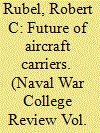

|
|
|
|
|
| Publication |
2011.
|
| Summary/Abstract |
The aircraft carrier has been around in various forms since the First World
War. Its emergence as the key denominator of naval power is legendary, and
its continuing prestige in this role is even yet spawning building programs
among established and growing navies. The aircraft carrier is the largest and
most complex of all warships and in most cases the most expensive. In addition
to the cost of the ship itself, that of the embarked air wing must be considered,
not to mention the extensive logistics and training infrastructure needed to keep
carriers operating and useful. A recent Naval Postgraduate School study has
shown that approximately 46 percent of the Navy's personnel-officer, enlisted,
and civilian-are assigned to positions either on or supporting its carriers.
1
For
these and other reasons, there has been almost constant debate over the past
ninety years within navies, between navies and air forces, and within governments over the advisability of investing in carriers. As the prospects for major
cutbacks in defense spending loom, the debate will again heat up. Both proponents and opponents of carriers have refined their arguments over the past nine
decades, but these are now starting to wear thin as the geopolitical environment
and the technology of war have changed. Also, the arguments both for and
against have tended toward the theological, with many tacit or unacknowledged
assumptions underpinning the argumentative maneuvers. In an attempt to improve the quality of the coming debates, this article will examine the prospects
for future utility of the ship type, including that of the embarked air wing, from
a different angle. Instead of making a holistic judgment on the future utility of
aircraft carriers, it will focus on the ways they have been, are, or could be used.
|
|
|
|
|
|
|
|
|
|
|
|
|
|
|
|
| 3 |
ID:
115007


|
|
|
|
|
| Publication |
2011.
|
| Summary/Abstract |
In the absence of a credible numbers-based theory of counterinsurgency there
can be no objective, numbers-based assessment for Operation ENDURING
FREEDOM. The U.S. military nonetheless has attempted to conduct a numbersbased assessment process. Thus, when a new commander and staff take over duties as a regional command in Afghanistan, they inherit an operations assessment process riddled with highly visible flaws that emanate from the improper
use of numbers and flawed logic. While no assessment process can be perfect or
free of any criticism, the flaws the author observed during a six-week stint
in-country are sufficiently egregious that they seriously reduce the value those
assessments provide to commanders' decision support. In addition, the visibility of these flaws means
that military assessments, and by association the military commanders, are rightfully distrusted by higher
civilian authority and by other organizations within
the theater. It is therefore imperative that incoming
commanders and staffs taking over responsibilities for
regional commands address these flaws to improve
decision making and to earn the trust of higher civilian authority and organizations with whom they have
to work.
|
|
|
|
|
|
|
|
|
|
|
|
|
|
|
|
| 4 |
ID:
115005
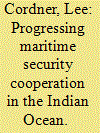

|
|
|
|
|
| Publication |
2011.
|
| Summary/Abstract |
The theme of the second Indian Ocean Naval Symposium (IONS), hosted in
Abu Dhabi by the United Arab Emirates (UAE) Navy on 10-12 May 2010,
was "Together for the Reinforcement of Maritime Security in the Indian
Ocean."
1
Navy chiefs of service and senior maritime security officers or their
representatives from thirty of the thirty-two Indian Ocean region (IOR) navies
and maritime security forces gathered for this significant event. Participants
from the diverse Indian Ocean littoral came from the Arabian Gulf and the Red
Sea, Africa, South Asia, Southeast Asia, and Australia.
2
Pakistan, which had declined an invitation to attend the first IONS meeting, in New Delhi in 2008, was
represented by the local air attaché. In addition, extraregional maritime force
participants included the U.S. Navy, represented by Commander, Naval Forces,
U.S. Central Command, Vice Admiral William
Gortney, and the Deputy Chief of Naval Operations,
Vice Admiral Bruce W. Clingan; the Italian Navy, represented by its chief, Admiral Bruno Branciforte; and
the Royal Navy of the United Kingdom, which sent a
senior delegation. Notable was the absence of participants from the navies of other external countries with
significant and growing interests in the IOR, for example, China, Russia, Japan, and the Republic of
Korea.
|
|
|
|
|
|
|
|
|
|
|
|
|
|
|
|
| 5 |
ID:
115003
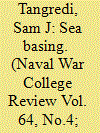

|
|
|
|
|
| Publication |
2011.
|
| Summary/Abstract |
Sea basing is a strategic concept that has been defined in a variety of often contradictory ways. It is officially a joint concept, but it is widely perceived as a parochial tool to justify budget increases for the Department of the Navy. As an
activity, sea basing has been described as both traditional and transformational.
1
Many proponents consider it a specific set of hardware-future platforms, such
as the mobile offshore base or additional ships for the Maritime Prepositioning
Force (MPF), like the proposed Mobile Landing Platform, which would allow
for selective off-load of prepositioned material while still at sea.
2
A misperceived
exclusive association with amphibious warfare, not currently a priority in the
Pentagon, has largely driven sea basing out of policy discussions at the Office of
the Secretary of Defense (OSD) level. Ironically, sea basing came to prominence
in the past decade under a Chief of Naval Operations (CNO) determined to cut
capabilities from the amphibious fleet so as to fund future surface combatants.
3
|
|
|
|
|
|
|
|
|
|
|
|
|
|
|
|
| 6 |
ID:
115004
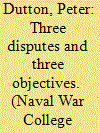

|
|
|
|
|
| Publication |
2011.
|
| Summary/Abstract |
The recent heightening of the competition between China and its neighbors
over sovereignty, resources, and security in the South China Sea has drawn
the attention of diplomatic and military leaders from many countries that seek
to promote stability and security in these globally important waters. For states
that ring the South China Sea, its waters represent a zone of rich hydrocarbon
and protein resources that are increasingly dear on land as populations exhaust
their territories' ability to meet their increasing needs. This resource competition alone could be the basis of sharp-edged disputes between the claimants.
However, the South China Sea also represents the projection of the cultural consciousness of the centuries-long relationship that each coastal nation has had
with its adjoining seas. This fact fuels competing modern-day nationalist tendencies among claimant-state populations, tendencies that in turn magnify the
importance of the disputes and, during times of crisis, narrow the options for
quiet negotiation or de-escalation.
|
|
|
|
|
|
|
|
|
|
|
|
|
|
|
|
| 7 |
ID:
115006
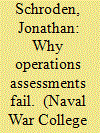

|
|
|
|
|
| Publication |
2011.
|
| Summary/Abstract |
In any military campaign, commanders, politicians, and the general public all desire to know whether the effort is succeeding. For conventional conflicts, well
developed theories of war give a good understanding of the objectives to pursue
and how to pursue them. These theories also enable the derivation of well defined metrics for progress, such as terrain held, numbers of enemy fighters killed
or captured, or amount of enemy equipment and materiel destroyed. In unconventional conflicts the theories of war are more complex, objectives and ways to
achieve them are less straightforward, and notions of "winning" and "losing" are
more difficult to define. As a result, it is also more difficult to gauge and demonstrate progress in such conflicts. For the specific case of counterinsurgency, however, gauging and demonstrating progress is at least as important as in a conventional war, since the former tends to last longer and therefore requires sustained
political and public support to conduct-and such support is often tied to proof
of progress. Thus operations assessment, designed to show whether progress is
being made, should be a vital part of any unconventional conflict, especially
counterinsurgency.
|
|
|
|
|
|
|
|
|
|
|
|
|
|
|
|
|
|
|
|
|